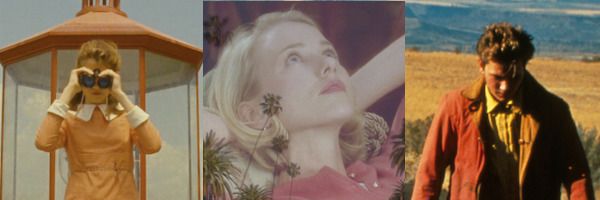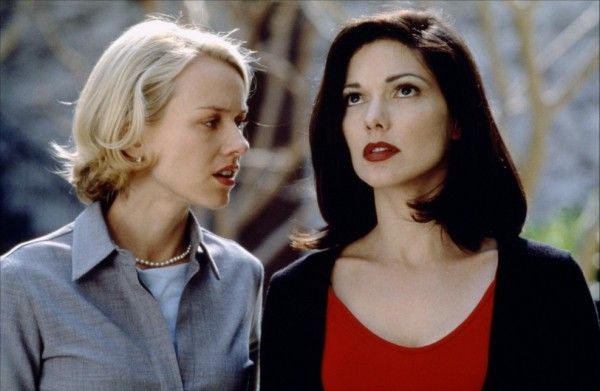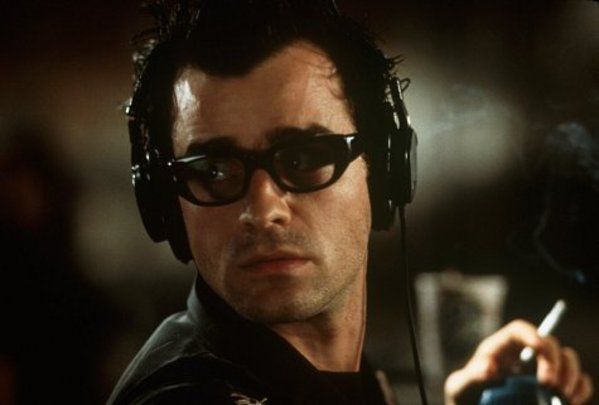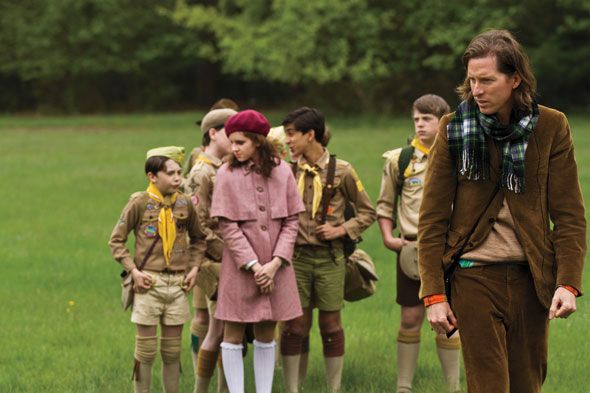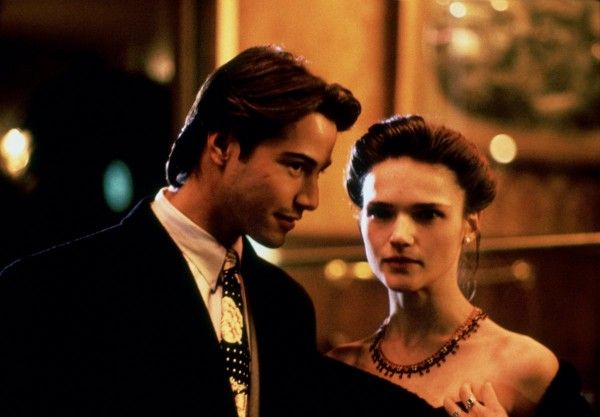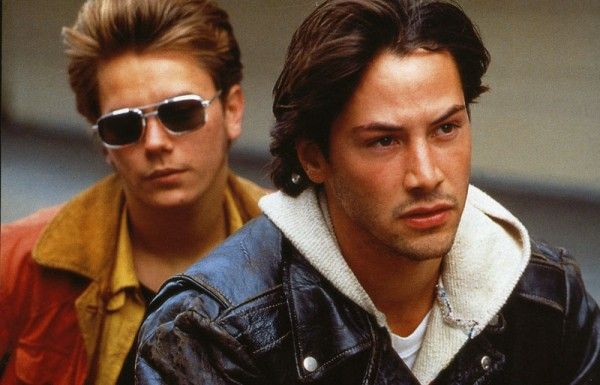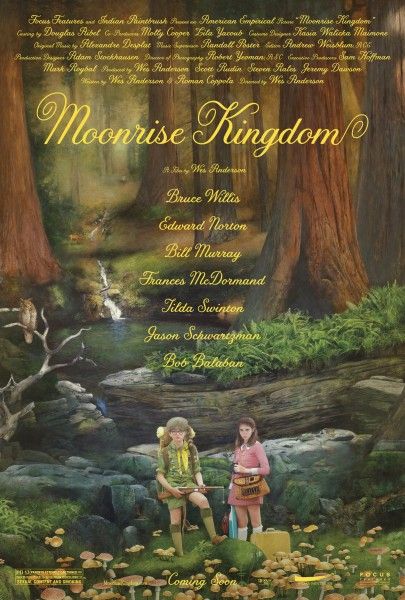Great American Arthouse auteurs get the Criterion treatment in this batch of releases, which include David Lynch’s Mulholland Dr., Wes Anderson’s Moonrise Kingdom, and Gus Van Sant’s My Own Private Idaho. All are essential additions to the collection.
What could be described as a "found art" project by cinema's foremost art-school dilettante, David Lynch's Mulholland Dr. is truly like no other film ever made and is one of those few films that actually rewards multiple viewings though its dreamy and confusing narrative. Buffeted by an introduction that suggests someone's dreams, Mulholland Dr. begins with the arrival of doe-eyed blonde Betty Elms (Naomi Watts), who's coming from Deep River, Ontario to Hollywood hoping to get her big acting break by relocating to her actress Aunt's apartment. While moving in Betty finds a dark-haired stranger naked in her aunt's shower. The stranger calls herself Rita (Laura Harring), but because of a car crash and assassination attempt she now has amnesia. The only clues to her identity are a pile of cash and strange blue key found in her purse.
As the two girls try and find out just who Rita is, director Adam Kesher (Justin Theroux) is told by men in suits that his new film must star the actress Camilla Rhodes (Melissa George) or else it will be shut down. He rejects this, but then Adam finds that not only is his wife sleeping with the pool man (Billy Ray Cyrus), but his project has been canceled, his assets frozen, and he's instructed to have a midnight meeting with someone named "The Cowboy." Though she has a killer audition for a neighboring project, and she catches Adam's eye, Betty's determined to continue her investigation after she and Rita stumble onto a clue in the name of Diane Selwin. As their sapphic interests are heightened by the chase, the clues lead them to Diane's apartment, where they break in to find a decomposing body. Then things get even more complicated.
Though it's hard to know what to make of the narrative, some of that has to do with the film's inception. Originally, Mulholland Dr. was to be Lynch's return to television, and though Lynch made a pilot for ABC, it never aired as it was deemed too weird for prime time. With a rabid David Lynch fan-base willing to consume anything the maestro exhumes, the pilot was resurrected when French investors gave Lynch enough money to turn the pilot into a feature film. And though there are revisions throughout, the first 90 minutes reportedly are pretty close to the original pilot, with the first few minutes and the second half almost exclusively the new stuff. Such may be why this R-rated film features bloodless on-screen killings in one section and hot lesbian sex in another — or it could be taken as intentional, if one embraces this as a dream narrative.
Because of this revisioning of the pilot project, there are entire sequences in Mulholland Dr. that seem to bear no meaning to the rest of the film. And since many feature names like Robert Forster, Dan Hedeya (both showing up for single scenes), and Billy Ray Cyrus, it's easy for a viewer to get hung up on such small bits (or wonder how these characters would have turned out had this become a TV series). But as confusing as it may be, Lynch has a master plan — he's just not going to connect the dots.
Mulholland Dr. is a film that starts to congeal on repeated viewing. Though the film sets up its rules and clues as any good mystery should, such is done through a dream-narrative wherein meaning is gained through knowing the real (a reality that is presented almost totally afterwards). With so much information, it's hard to hold all the pieces together until one knows what the pieces are for.
The value of Mulholland Dr. comes down to how much the viewer is willing to invest into the film. The more you have fun connecting the dots, the better time you'll have watching it. An important clue is the box that, when unlocked, causes Rita to disappear. What is the box? Is it a gesture towards Pandora's box, or is it a more literal nod to a slang interpretation of box? That's the fun of it, as Mulholland Dr. is a mystery open to all interpretations and theories, with none more valid than the next, making Mulholland Dr. the most playful movie David Lynch has made.
Criterion presents the film in widescreen (1.85:1) and in DTS-HD 5.1 master audio. The film was previously released on DVD after the film came out, and the difference in presentation is night and day. This was always a good looking film, but the Blu-ray is just next level great. As is the case with Lynch, there are no chapters, so the menu only offers two options: the film and the supplements. The work Criterion has done here is excellent as they get Lynch and the main cast to talk about the film. There are interviews with David Lynch and Naomi Watts (27 min.) where the two talk about the work and how it partly reflected where Watts was at her career at the time. The reason why she’s taken seriously now as a performer has everything to do with this film, and though it would have been nice to have more time with Lynch alone, he’s always been cagey about his process, so this is likely the best possible outcome. Watts shows up in the actors section, where she’s joined by Harring, Theroux and casting director Johanna Ray (36 min.), and that’s a great talk where everyone talks about where they were in their careers when they came into the project, the casting process, going from thinking it was a TV show, to making a movie, and how the project changed their careers. Composer and co-star Angelo Badalamenti (20 min.) gets his own section to talk about both his acting experience and his score, and how he came up with the main theme, while production designer Jack Fisk and cinematographer Peter Demming (23 min.) also speak on how the film came together, and keeping locations matched to what was previously shot, which was more difficult as almost everything made for the pilot version was thrown out.
It would have been wonderful if Criterion could have swayed Lynch to allow them to release the pilot version of the movie, but instead one deleted scene is included, which offers more of Robert Forster (3 min.) investigating the car crash. Also included is on set footage (25 min.) which is raw look at Lynch directing a sequence. It’s fascinating, though also a little tedious. The film’s theatrical trailer is also included.
Wes Anderson’s Moonrise Kingdom represented a turning point in the filmmaker’s career. To that point his films were almost exclusively about sons (and daughters) and their relationships with fathers or father figures (Bottle Rocket deviates from this slightly, though that’s still a big part of the narrative). It was a rut, something apparent in The Life Aquatic and The Darjeeling Limited, something that needed to be shook loose. Anderson tried that partly by moving to stop motion animation, but with Moonrise he had a full break from those patterns, as he told the love story of Sam (Jared Gilman) and Suzy (Kaya Hayward). Sam is an orphan, while Suzy is frustrated with her family, so they decide to run off together. This brings in Scout Master Ward (Edward Norton), who was Sam’s Khaki Scout leader, the town’s sheriff Captain Sharp (Bruce Willis), and Suzy’s parents (Bill Murray, Frances McDormand), and many of the Khaki scouts that are deputized by Sharp. But with Sam running off, Social Services (Tilda Swinton) is called in as Sam is no longer welcome at his foster home. What will become of them?
Anderson’s melancholic love story is a remarkable achievement in a number of ways, but partly because it unlocked something in Anderson. It opened him up and led to his next masterpiece, The Grand Budapest Hotel, but it also connected to the childlike wonder that has always been in his films. Many of his characters have come across as grown up children, but by having his main characters be children it allows for a sense that these are still people being formed. Sam and Suzy are wonderful protagonists who are very empathetic, who are both wise, but also not above putting on airs. The film also embraces the idea of community in a way that’s touching. Anderson has been a great artist since he began making movies, but here he showed that he has more stories to tell in the most exciting way possible. It’s a great work.
Criterion presents the film in widescreen (1.85:1) and in DTS-HD 5.1 Master Audio. Though the film had previously been released on Blu-ray this is a slight step up in terms of picture and quality, partly because it was given hands-on attention by Anderson himself. The film comes with a commentary track by Anderson, Criterion’s Peter Becker and young star Jake Ryan, who call co-writer Roman Coppola, Bill Murray, and Edward Norton to talk about the movie. Everyone has good comments, with Murray a standout as he references that his role in Rushmore reminds him of Akira Kurosawa’s Red Beard, and notes that he’s never seen Bottle Rocket. It’s a good track.
There are eleven iPhone videos taken by Edward Norton (21 min.) who introduces them, and they show a happy and productive set where everyone is having fun making the movie. There are making of segments, with “Exploring the Set” (18 min.) the most engaging as Anderson’s assistant Martin Scali had an all access pass to the set on captured a lot. It’s followed by “Storyboards, Animatics and Narrator Tests” (9 min.) which cover four different scenes in the film. There’s also “Auditions” (5 min.) which offer an early look at the young actors who appeared in the film, while “Miniatures” (2 min.) looks at the models used in the film. Also new is “Benjamin Britten's ‘Noye's Fludde’ which highlights a music piece used in the film. There are also featurettes that have been previously released, which include “Welcome to New Penzance” (4 min.) which looks at the locations in less detail, “Set Tour with Bill Murray” (3 min.), “Animated Books” (5 min.) which narrates some of Suzy’s books, “Cousin Ben” (2 min.) a short film that highlights Jason Schwartzman’s character in the film, and the film’s theatrical trailer
My Own Private Idaho was the film that showed both Keanu Reeves and River Phoenix were capable of multitudes. Everyone knew that Phoenix was someone special, but Reeves was known for playing stoner types, while here he stretched. Phoenix stars as Mike Waters, a gay prostitute who suffers from narcolepsy, which leads him to fall asleep at inopportune times. He’s best friends with Scott Favor (Reeves), who also tricks but comes from a rich family, and is slumming as a way to be a prodigal son. They’re both friends with Bob Pidgeon (William Richert), who is Falstaff to Scott’s King Henry – literally, as the film is based on the works of William Shakespeare. Eventually the two quest to find Mike’s missing mom, and though Scott is only gay for pay, Mike has feelings for Scott he can’t ignore.
If Van Sant had been able to make the Shakespeare aspects of the film work, My Own Private Idaho would be one of the greatest films of all time. As it is, the film is lumpy, but filled with undeniable greatness, as the film was obviously hugely influential on both Todd Haynes and Wong Kar-Wai. Van Sant was chasing something, and his portrayal of Portland in that time, and his experimental touches are awe inspiring, but as is sometimes the case with Van Sant, he doesn’t have a great handle on how to complete the narrative. Regardless of those shortcomings, the performers are excellent and there is enough going on that it’s worth taking the lumps when the film seems a tad off. It’s one of the most important films of the 1990’s, without question, even if its reach exceeds its grasp.
Criterion’s Blu-ray presents the film widescreen (1.85:1) and in both DTS-HD 5.1 and 2.0 Master Audio. The film looks amazing on Blu-ray and the film’s picture and sound upgrades are great. Haynes and Van Sant (54 min.) sat down to talk about the movie as something of a commentary track, and the two cover a lot of the movie, with Haynes a great prodder of the often closed off Van Sant. It’s followed by a great making of (43 min.) with editor Curtis Clayton, directors of photography John Campbell and Eric Alan Edwards, and production designer David Brisbin, where they talk about what went into the making of the film, its challenges, and how it all came together.
Producer Laurie Parker and Rain Phoenix (20 min.) speak to River’s great performance in the film, and how great he was in the movie, how it was one of the most important films in his career, while film scholar Paul Arthur walks through the movie and its greatness in “Kings of the Road” (45 min.) in a eleven part study of the film. Author JT LeRoy (nee Laura Albert) and filmmaker Jonathan Caouette (54 min.) also talk about the greatness in the film and how it influences their work. Also included are six deleted scenes (13 min.) in rough shape, and the film’s theatrical trailer.

